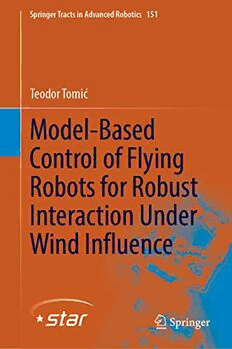Table Of ContentSpringer Tracts in Advanced Robotics 151
Teodor Tomić
Model-Based
Control of Flying
Robots for Robust
Interaction Under
Wind Influence
Springer Tracts in Advanced Robotics
Volume 151
SeriesEditors
BrunoSiciliano,DipartimentodiIngegneriaElettricaeTecnologie
dell’Informazione,UniversitàdegliStudidiNapoliFedericoII,Napoli,Italy
OussamaKhatib,ArtificialIntelligenceLaboratory,DepartmentofComputer
Science,StanfordUniversity,Stanford,CA,USA
AdvisoryEditors
NancyAmato,ComputerScience&Engineering,TexasA&MUniversity,College
Station,TX,USA
OliverBrock,FakultätIV,TUBerlin,Berlin,Germany
HermanBruyninckx,KULeuven,Heverlee,Belgium
WolframBurgard,InstituteofComputerScience,UniversityofFreiburg,Freiburg,
Baden-Württemberg,Germany
RajaChatila,ISIR,Pariscedex05,France
FrancoisChaumette,IRISA/INRIA,Rennes,Ardennes,France
WanKyunChung,RoboticsLaboratory,MechanicalEngineering,POSTECH,
Pohang,Korea(Republicof)
PeterCorke,QueenslandUniversityofTechnology,Brisbane,QLD,Australia
PaoloDario,LEM,ScuolaSuperioreSant’Anna,Pisa,Italy
AlessandroDeLuca,DIAGAR,SapienzaUniversitàdiRoma,Roma,Italy
RüdigerDillmann,HumanoidsandIntelligenceSystemsLab,KIT-Karlsruher
InstitutfürTechnologie,Karlsruhe,Germany
KenGoldberg,UniversityofCalifornia,Berkeley,CA,USA
JohnHollerbach,SchoolofComputing,UniversityofUtah,SaltLake,UT,USA
LydiaE.Kavraki,DepartmentofComputerScience,RiceUniversity,Houston,TX,
USA
VijayKumar,SchoolofEngineeringandAppliedMechanics,Universityof
Pennsylvania,Philadelphia,PA,USA
BradleyJ.Nelson,InstituteofRoboticsandIntelligentSystems,ETHZurich,
Zürich,Switzerland
FrankChongwooPark,MechanicalEngineeringDepartment,SeoulNational
University,Seoul,Korea(Republicof)
S.E.Salcudean,TheUniversityofBritishColumbia,Vancouver,BC,Canada
RolandSiegwart,LEEJ205,ETHZürich,InstituteofRobotics&Autonomous
SystemsLab,Zürich,Switzerland
GauravS.Sukhatme,DepartmentofComputerScience,UniversityofSouthern
California,LosAngeles,CA,USA
TheSpringerTractsinAdvancedRobotics(STAR)publishnewdevelopmentsand
advances in the fields of robotics research, rapidly and informally but with a high
quality. The intent is to cover all the technical contents, applications, and multi-
disciplinaryaspectsofrobotics,embeddedinthefieldsofMechanicalEngineering,
Computer Science, Electrical Engineering, Mechatronics, Control, and Life
Sciences,aswellasthemethodologiesbehindthem.Withinthescopeoftheseries
aremonographs,lecturenotes,selectedcontributionsfromspecializedconferences
andworkshops,aswellasselectedPhDtheses.
Specialoffer:Forallclientswithaprintstandingorderweofferfreeaccesstothe
electronicvolumesoftheSeriespublishedinthecurrentyear.
IndexedbySCOPUS,DBLP,EICompendex,zbMATH,SCImago.
AllbookspublishedintheseriesaresubmittedforconsiderationinWebofScience.
Teodor Tomic´
Model-Based Control
of Flying Robots for Robust
Interaction Under Wind
Influence
TeodorTomic´
SanFrancisco,CA,USA
ISSN 1610-7438 ISSN 1610-742X (electronic)
SpringerTractsinAdvancedRobotics
ISBN 978-3-031-15392-1 ISBN 978-3-031-15393-8 (eBook)
https://doi.org/10.1007/978-3-031-15393-8
©SpringerNatureSwitzerlandAG2023
Thisworkissubjecttocopyright.AllrightsarereservedbythePublisher,whetherthewholeorpartof
thematerialisconcerned,specificallytherightsoftranslation,reprinting,reuseofillustrations,recitation,
broadcasting,reproductiononmicrofilmsorinanyotherphysicalway,andtransmissionorinformation
storageandretrieval,electronicadaptation,computersoftware,orbysimilarordissimilarmethodology
nowknownorhereafterdeveloped.
Theuseofgeneraldescriptivenames,registerednames,trademarks,servicemarks,etc.inthispublication
doesnotimply,evenintheabsenceofaspecificstatement,thatsuchnamesareexemptfromtherelevant
protectivelawsandregulationsandthereforefreeforgeneraluse.
Thepublisher,theauthors,andtheeditorsaresafetoassumethattheadviceandinformationinthisbook
arebelievedtobetrueandaccurateatthedateofpublication.Neitherthepublishernortheauthorsor
theeditorsgiveawarranty,expressedorimplied,withrespecttothematerialcontainedhereinorforany
errorsoromissionsthatmayhavebeenmade.Thepublisherremainsneutralwithregardtojurisdictional
claimsinpublishedmapsandinstitutionalaffiliations.
ThisSpringerimprintispublishedbytheregisteredcompanySpringerNatureSwitzerlandAG
Theregisteredcompanyaddressis:Gewerbestrasse11,6330Cham,Switzerland
ForAlfred
Foreword
Atthedawnofthecentury’sthirddecade,roboticsisreachinganelevatedlevelof
maturityandcontinuestobenefitfromtheadvancesandinnovationsinitsenabling
technologies.Theseallarecontributingtoanunprecedentedefforttobringingrobots
to human environment in hospitals and homes, factories, and schools; in the field
for robots fighting fires, making goods and products, picking fruits, and watering
the farmland, saving time and lives. Robots today hold the promise for making
a considerable impact in a wide range of real-world applications from industrial
manufacturingtohealthcare,transportation,andexplorationofthedeepspaceand
sea.Tomorrow,robotswillbecomepervasiveandtouchuponmanyaspectsofmodern
life.
TheSpringerTractsinAdvancedRobotics(STAR)isdevotedtobringingtothe
research community the latest advances in the robotics field on the basis of their
significanceandquality.Throughawideandtimelydisseminationofcriticalresearch
developmentsinrobotics,ourobjectivewiththisseriesistopromotemoreexchanges
andcollaborationsamongtheresearchersinthecommunityandcontributetofurther
advancementsinthisrapidlygrowingfield.
The monograph by Teodor Tomic´ is based on the author’s doctoral thesis.
The contents are focused on aerial robotics and are organized in seven chapters.
Robustmodel-basedcontroltechniquesareproposedforautonomousflyingrobots
physicallyinteractingwiththeenvironmentwhileundertheinfluenceofwind.
The book develops four essential phases of Fault Detection, Identification, and
Recovery (FDIR) in terms of detection, classification, isolation, and recovery of
collisionswiththeenvironment.
Richofexamplesdevelopedbymeansofsimulationandextensiveexperimenta-
tiononprototypeandcommercialflyingplatforms,thisvolumewastheco-winner
of the 2019 Georges Giralt Ph.D. Award for the best doctoral thesis in Europe. A
veryfineadditiontotheSTARseries!
Naples,Italy BrunoSiciliano
July2022 STAREditor
vii
Preface
This monograph is based on my Ph.D. thesis written at the Institute of Robotics
andMechatronicsoftheGermanAerospaceCenter(DLR)inOberpfaffenhofenand
while working at Skydio in Redwood City, CA, USA. The thesis was defended at
theLeibnizUniversityofHannover(LUH)inSeptember2018.
Thisbookaddressesthetopicofautonomousflyingrobotsphysicallyinteracting
withtheenvironmentwhileundertheinfluenceofwind.Itaimstomakeaerialrobots
awareofthedisturbance,interaction,andfaultsactingonthem.First,thebookaims
tomakeflyingrobotsawareofcontactsandcollisions,byprovidingalow-leveldetec-
tionandreactionframework.Thisrequiresthereasoningabouttheexternalwrench
(forceandtorque)actingontherobot,anddiscriminating(distinguishing)between
wind,interactions,andcollisions.Second,thisbookaimstoprovideanestimateof
thewindvelocitythatisindependentoftheexternalwrench.Thisallowsamotion
planner to reason about future external forces based on the aerodynamics model.
Finally,thisbookaimstobridgethegapbetweentrajectorytrackingandinteraction
control,toallowphysicalinteractionunderwindinfluence,whichismadepossible
bythediscriminationoftheseforces.Ittakesamodel-basedapproachtodiscriminate
betweentheforcessimultaneouslyactingontherobot,comingfromphysicalinter-
action,disturbancessuchaswind,andfaultssuchascollisions.Toachievethis,the
bookcoversasystematicapproachtomodelingandparameteridentificationforflying
robots. Aerodynamics model identification is approached in a data-driven fashion,
usingground-truthmeasurementsobtainedina3Dwindtunnel.Properreactionis
requiredasaresponsetoeachexternalinfluence:therobotshouldrejectdisturbances
forprecisepositioninginwind,reactcompliantlytophysicalinteractions,andreact
intelligently to faults. Robust trajectory tracking control for disturbance rejection,
anddeliberatephysicalinteractioncontrolaredevelopedforthispurpose.Tounder-
stand the disturbance and discriminate between wind and interaction, methods for
windestimationaredeveloped,includinganovelmethodtoestimatethewindspeed
usingmotorpowermeasurements.Thebookfurtherdevelopsfouressentialphases
of Fault Detection, Identification, and Recovery (FDIR) in the context of flying
robots.Collisiondetectionprovidesbinaryinformationwhetheracollisionwiththe
environment has occurred. Collision classification provides information about the
ix
x Preface
collisiontype.Thelocationofthecollisionisobtainedthroughcollisionisolation.
Lastly,appropriatecollisionrecoverymitigatesdanger.Thisconceptisexpandedto
flyingrobotswarms.Theoreticalresultsareaccompaniedbyextensivesimulationand
experimentalresultsonbothexperimentalandcommercialflyingrobotplatforms.
Thecontentsofthismonographpresenttheculminationofsevenyearsofpersonal
andprofessionalgrowth.Iamthankfulforbeinggiventherareopportunitytowork
inintelectuallyinspiringanddemandingenvironmentsthathavepushedmetonew
heights.Mostoftheworkrelatingtothisthesiswasdoneduringmysixyearsatthe
GermanAerospaceCenter(DLR)InstituteofRoboticsandMechatronics,whereas
forthelastyearthereofIhavebeenatSkydio.Iwouldalsoliketothankmyclose
familyforthesupportthroughouttheyears.
The most credit for finishing this thesis goes to Prof. Haddadin, who has not
only been a true mentor, but also a good friend. By always demanding the best,
withoutcompromises,hetaughtmehowtoapproachproblemswithgoodscientific
questionsandtoneverquitpushingtowardssetgoals.Iwillrememberthesleepless
nightsbeforedeadlines,andthelongtrainridesfilledwithinterestingdiscussions.
Many people have supported me at DLR. I am grateful to Alin Albu-Schäffer,
MichaelSuppa,KorbinianSchmid,HeikoHirschmüller,ArminWedler,andChris-
tian Ott for giving me the opportunity to join and work with the amazing people
at DLR. Due to my long tenure at DLR, there are figuratively countless people to
thank for engaging discussions. I would like to thank Michael Kaßecker for the
endlessdiscussionsaboutallthingmechanicalandelectrical,andothersocialinep-
titude(likecomputerscience,life,theuniverse,andeverything).Theinstitutionof
Florian Schmidt, always ready to help, listen, talk, and party, will always remain
an inspiration. I am also thankful to have worked with Elmar Mair, Felix Rueß,
Moritz Maier, Christoph Brand, Martin Schuster, Iris Grixa, Samantha Stoneman,
MarcusMüller.IhavealsolearnedagreatdealfromdiscussionswithDanielSeth,
Oli Eiberger, Robert Haslinger, Alexander Werner, Johannes Englsberger, Oliver
Porges, and almost everyone at DLR. It has been a great period in my career and
life.RelatingtowindtunnelexperimentsanddevelopmentoftheDLRArdeahexa-
copter,IwouldespeciallyliketothankPhilippLutz,Ingov.Bargen,HaraldWagner,
TiloWüsthoff,andMarkusGrebenstein.Lastly,AndrewMathershassupportedthe
experimentsatWindEEEinLondon,Canada.IngoKossykandSaumitroDasgupta
havebeenagreathelponthemachinelearningsideofthings.
I really appreciate the opportunity to work with people that make up Skydio
throughout the years, and their support and understanding during the last year of
writing this thesis, most notably Hayk Martyros, Adam Bry, Abraham Bachrach,
RowlandO’Flaherty,andSaumitroDasgupta.
I would like to thank Prof. Bruno Siciliano, the team of Springer, and the
committee of the Georges Giralt Ph.D. Award for giving me the opportunity to
publishmyresearchfindingsintheSpringerTractsinAdvancedRobotics.
SanFrancisco,USA TeodorTomic´
July2022
Contents
1 Introduction ................................................... 1
1.1 ProblemStatement ........................................ 3
1.2 RelatedWork ............................................. 4
1.3 Contributions ............................................. 13
References ..................................................... 17
2 Modeling ...................................................... 23
2.1 DynamicsModel .......................................... 24
2.1.1 RigidBodyDynamics ............................... 24
2.1.2 PropulsionWrench .................................. 26
2.1.3 PropellerAerodynamics ............................. 27
2.1.4 SimplifiedDragModel .............................. 29
2.1.5 ReducedBrushlessDCMotorModel .................. 30
2.2 ParameterIdentification .................................... 31
2.3 ExternalWrenchEstimation ................................ 36
2.3.1 Momentum-BasedEstimation ........................ 37
2.3.2 Acceleration-BasedEstimation ....................... 37
2.3.3 HybridEstimation .................................. 38
References ..................................................... 39
3 TrackingandInteractionControl ................................ 41
3.1 TrajectoryTrackingControl ................................. 41
3.1.1 AttitudeTrackingControl ............................ 41
3.1.2 PositionTrackingControl ............................ 46
3.1.3 EvaluationofTrajectoryTracking ..................... 48
3.2 InteractionControl ........................................ 54
3.2.1 ImpedanceControlwithInertiaShaping ................ 54
3.2.2 CompensatedImpedanceControl ..................... 62
3.2.3 AdmittanceControl ................................. 63
3.2.4 DiscussionandPracticalConsiderations ................ 64
3.2.5 ExperimentalValidationofImpedanceControl .......... 65
xi

